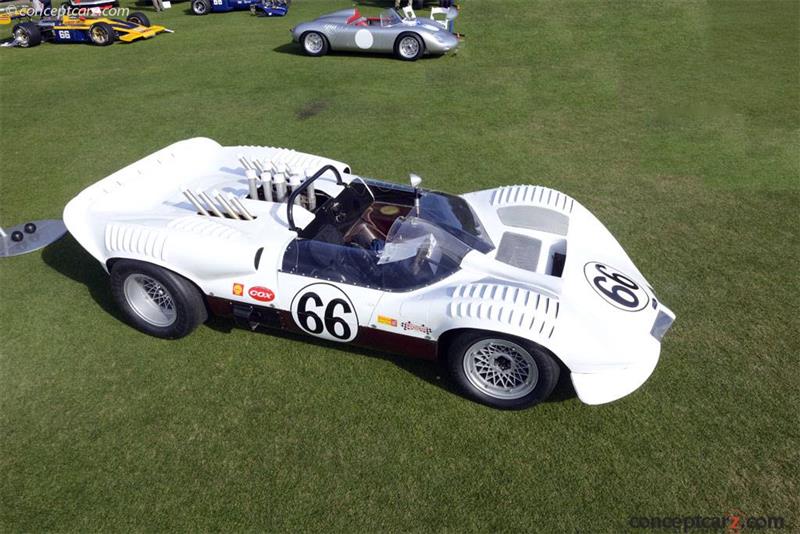Dick Troutman and Tom Barnes worked at Kurtis Kraft where they polished their metal-smith craft and fine-tuned their engineering expertise. They were responsible for the Troutman-Barnes Mercury Special of 1952, the Reventlow Scarabs of 1957 and 1958, and the first Chaparral of the early 1960s. They were pioneers of early American racing and helped push the classic front-engined sports racing roadsters to perhaps the height of their evolution.
Sports Racer
Chassis #: 2002
View info and historyTroutman and Barnes left the Reventlow operation in the fall of 1960 and went searching for a new source to back their venture. Their goal was to utilize a GM powerplant in a short-wheelbase vehicle where the engine would be mounted as far back as possible, in an effort to achieve near 50-50 weight distribution. The design was basically an improved Scarab that was lower, lighter, shorter, and weighed a few hundred pounds less. The racer was to have a fully independent rear suspension, all-wheel disc brakes, and centralized fuel tanks. Barnes and Troutman called it their 'Riverside Sports Racer.' At Riverside in November, the partners found Texas oil businessman, Jim Hall. Hall had competed in his first race in 1954 driving his brothers Austin Healey 100. This was the start of a passion that would continue to flourish throughout the years. From the Austin Healey, Hall moved into a Ferrari 750 Monza that had been driven by Carroll Shelby and Phill Hill to second overall in the 1955 Sebring 12 Hour race. Other early race cars driven by Hall included a Lister, a 2.5-liter F1 Lotus, and a Maserati 450S. Work began on this 'all-American' race car with incremental testing done at Halls race track which he had constructed south of Midland, Texas. Troutman and Barnes's goal was to build five cars; Hall had purchased two of them, effectively giving them the budget to continue their project. Four cars would eventually be created with one being exported to Great Britain. Halls's second Chaparral 1 was slightly different from his first car; it had an enlarged chassis which provided some additional room for the very cramped cockpit. One interesting feature of this car was its chin spoiler which was rather uncommon at the time.
Sports Racer
Chassis #: 2002
View info and historyThe first completed car had a wheelbase that measured 88 inches and a chassis constructed of 1.25-inch 4130 chrome-moly steel tubes. This 'space frame' multi-tubular structure was stiffened by a magnesium firewall and front bulkhead and by aluminum panels rived in place. The front suspension was comprised of double wishbones with coil springs and tubular shocks, plus an anti-roll bar. The brakes were cast-iron discs clamped by Girling calipers. The steering was from a Triumph Herald. Mounted far back in the engine bay was a small-block Chevrolet V8 engine stroked by Art Oehrli of Traco to 318 cubic inches. It produced around 300-325 horsepower and drove through an aluminum flywheel with Schiefer clutch, and a stock Corvette four-speed, aluminum-cased transmission. The transmission was located left of the driver, making for very cramped quarters. The body was made of aluminum which helped achieve a low weight of 1,479 pounds. Duplicates were advertised at $16,500.Grateful for the financial assistance provided by Hall, Troutman and Barnes invited him to rename their Riverside Sports Racer. Hall selected 'Chaparral' after a Texas running bird. 
Sports Racer
Chassis #: 2002
View info and historyThe new Chaparral made its racing debut at the 1961 SCCA race at Laguna Seca where it was piloted by Hall. It came in second behind a Maserati 'Birdcage', though it may have come in first had it not been for a broken valve rocker. Jim Hall's Troutman and Barnes built Chaparral's were chassis number 001 (the 88-inch car) and chassis number 003. Harry Heuer, a brewery-sponsored driver, purchased chassis number 002. Chassis 004 eventually went to Chuck Jones' TMI team. 005, without its bodywork, went to English hill climb champion, Philip Scragg. These front-engined cars were exceptionally fast and competitive, though the mid-engine layout would soon prove to be the more capable configuration. Another Achilles heel for the cars were their inboard-mounted rear discs which were tremendously difficult to cool. In 1962, at the Sebring 12 Hour race, the first Chaparral victory was scored. The winning car was driven by sharp/Hissom to a first-in-class and sixth-overall victory. Two more victories would be earned by the car at Road America. The Chaparral 1 car's final official race was at the 1963 Sebring 12 Hour race, where both cars entered failed to finish.The Chaparral 2
Work on an all-new mid-engine racecar was done at their workshop at the Rattlesnake race track in Texas. The team worked off a design that was created completely in-house. Hall relied on his extensive racing background when creating the modern chassis.
Sports Racer
Chassis #: 2002
View info and historyThe new car had a monocoque chassis and though this setup had been successful with front-engined race cars, it had never been done for a mid-engine car. To help with the chassis construction, Hall and Sharp enlisted the help of former airplane engineer Andy Green. Green had experience working with composite materials which would come in handy in construction of the fiberglass chassis. Hall wanted fiberglass because he felt it would be easier to construct and repair, plus it may even be easier to adapt to mechanical changes than traditional materials. While work was being done the new mid-engine sports racer, Colin Chapman of Lotus introduced the monocoque Lotus 25 Formula 1 racer. This new F1 car had an aluminum chassis and a fiberglass body. This was the first single monocoque single-seater, and it was soon to be followed by the world's first mid-engine monocoque sports racer.The new Chaparral was completed in time for the final races of the 1963 season. It was powered by a Chevrolet V8 engine with four Weber carburetors that offered around 415 horsepower. The powerplant was mated to a Colotti four-speed gearbox and there were Girling disc brakes in both the front and rear. The body design, inspired by the Chevy Monza GT Concept, was originally penned as a closed body. This was later discarded and replaced with a roadster body. The new racecar was called '2.'
Sports Racer
Chassis #: 2002
View info and historyIn 21 races during 1965, the Chaparral 2 won 16 and set the fastest lap in 14 races. During the 1963 through 1965 road racing seasons, versions of the car earned 22 wins in 39 races against world-class international competition.Chaparral 2 made its debut at Riverside Grand Prix in October where it captured the pole position. As would be expected from such a bold new concept, the car would experience teething pains. During the race, the car suffered from an electrical fire which forced it to retire prematurely from the race. The car continued to compete throughout the close of the season, with its best finish being a third place.After the 1963 season, Hall decided to retire from Formula 1 to focus on Sports Car racing and to further develop the '2.'
Sports Racer
Chassis #: 2002
View info and historyOn the off-season, Hall and his team built another Chaparral 2 from General Motors. Since GM had a non-racing agreement at the time, the project was labeled as an experimental vehicle. The new car, dubbed the Corvette GSIIb, had an aluminum chassis which was light but not as rigid as the other Chaparral. For the 1964 season, Chaparral fielded two works racers. Changes had been made with the most obvious being to the bodywork and to the exhaust system. The first race of the season earned Chaparral a second-place finish, followed by the car's first overall victory at the second race of the season. This would be the start of a very impressive career that would include many victories. Two more victories were earned by Roger Penske in the Chaparral at Laguna Seca and in the Nassau Speed Week.In 1965, Hall and Sharp began the season with an impressive victory at the Sebring 12 Hour race. 
Sports Racer
Chassis #: 2002
View info and historyLate in the season, the 2C version was introduced. It had a conventional aluminum chassis and would take the fastest lap and overall victory at the 1966 Sebring race.For the 1966 season, the USSRC was replaced by the Can-Am Challenge series. To comply with FIA requirements, the 2 was turned into the fixed-head 2D. In this guise, it scored the company's first European victory at the Nurburgring 1000 KM race. The 2E Can-Am racer used the aluminum 2C chassis. Though Hall continued to develop and fine-tune the cars, the aerodynamics, and the designs, they were not able to compete with the fierce competition.In total, Chaparral created four examples. Only three of the four examples were used, and those three examples were later converted to either 2F or 2D configurations. All examples have survived and currently, there is 1 '2', a '2D', and a '2F'.
Sports Racer
Chassis #: 2002
View info and historyOver the course of two seasons, the futuristic Chaparral 2's scored many victories and enjoyed a very successful career. The design, creativity, and ingenuity were revolutionary and was well ahead of its time. Chaparral 2 won the 1965 12 Hours of Sebring, dominated the 1965 United States Road Racing Championship and with its unique automatic transmission, advanced aerodynamics and Chevy V8 engine, changed championship sports car racing profoundly.
by Daniel Vaughan | Mar 2012

Sports Racer
Chassis #: 2002
View info and history
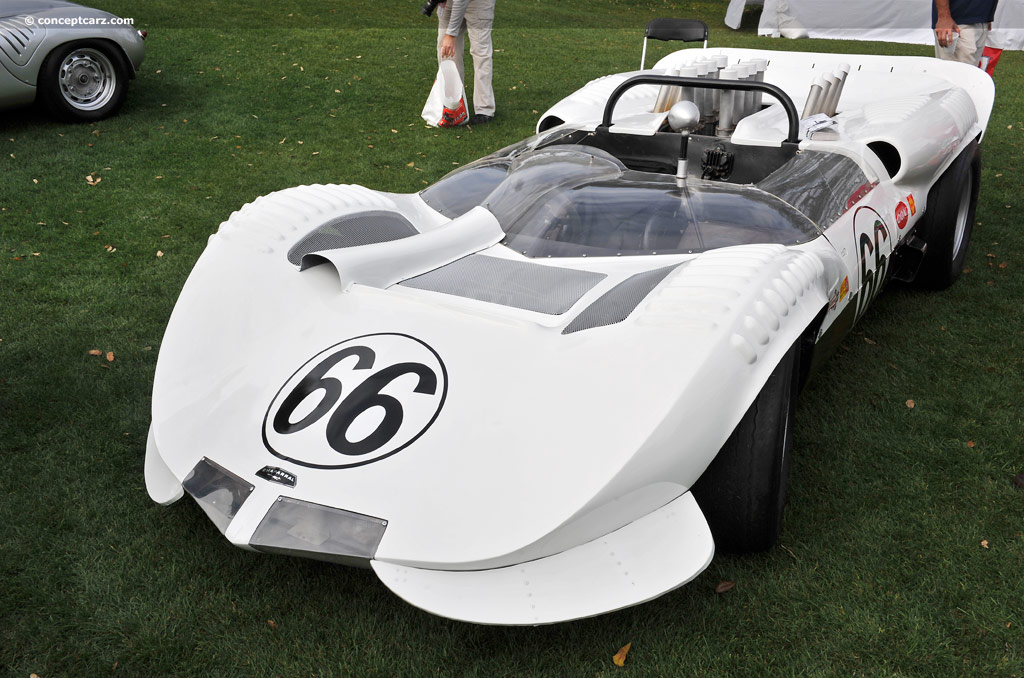
Sports Racer
Chassis #: 2002
View info and history

Sports Racer
Chassis #: 2002
View info and history
Work on an all-new mid-engine racecar was done at their workshop at the Rattlesnake race track in Texas. The team worked off a design that was created completely in-house. Hall relied on his extensive racing background when creating the modern chassis.

Sports Racer
Chassis #: 2002
View info and history
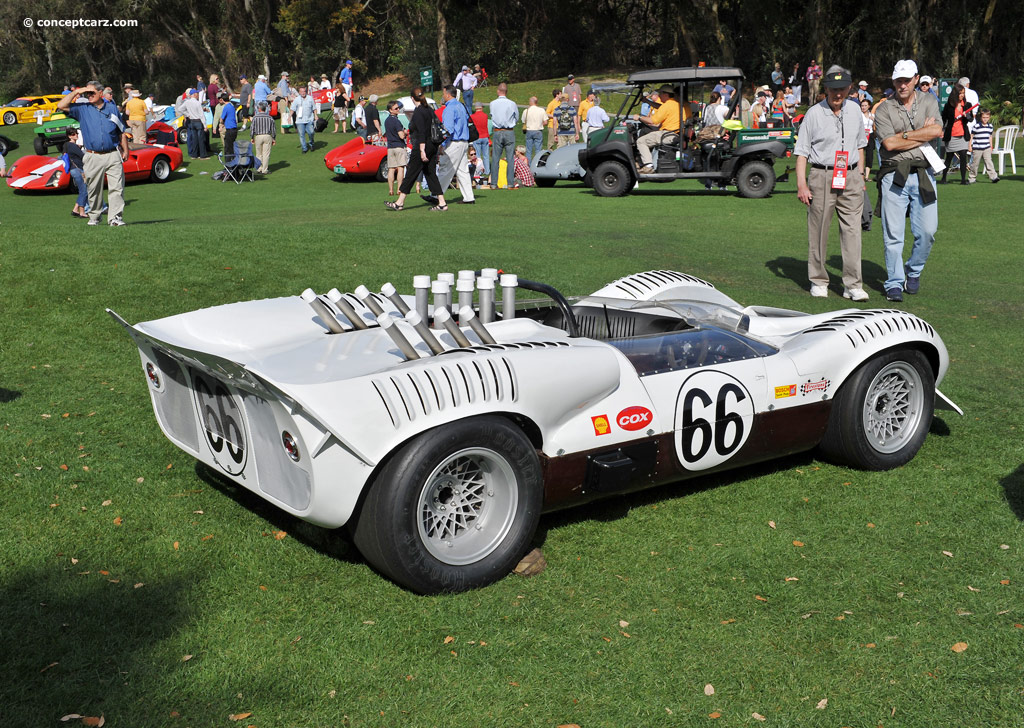
Sports Racer
Chassis #: 2002
View info and history
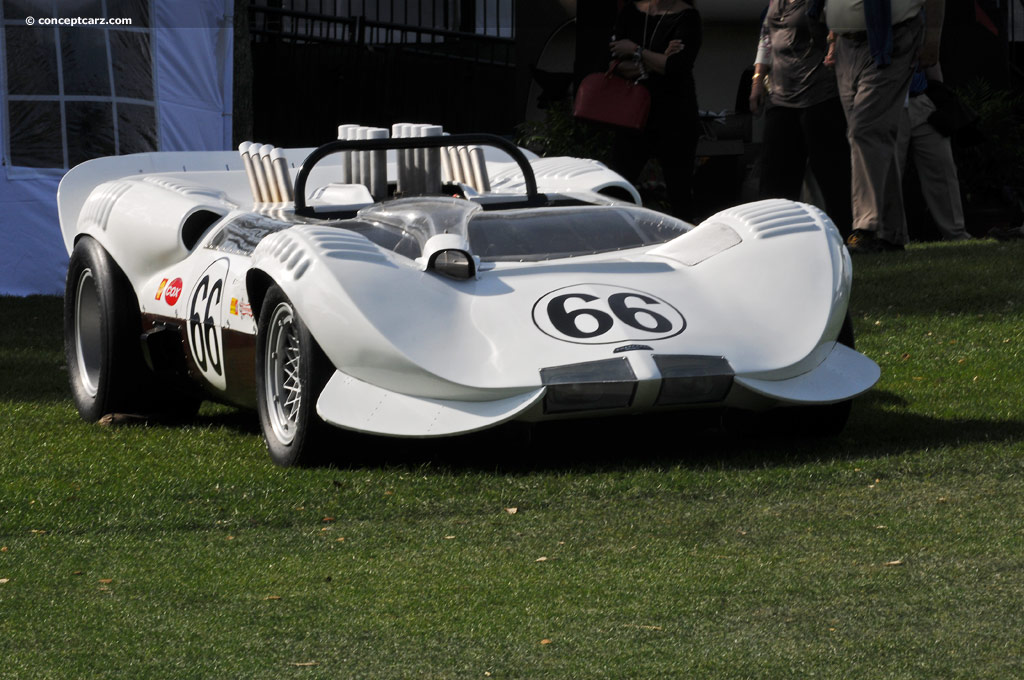
Sports Racer
Chassis #: 2002
View info and history
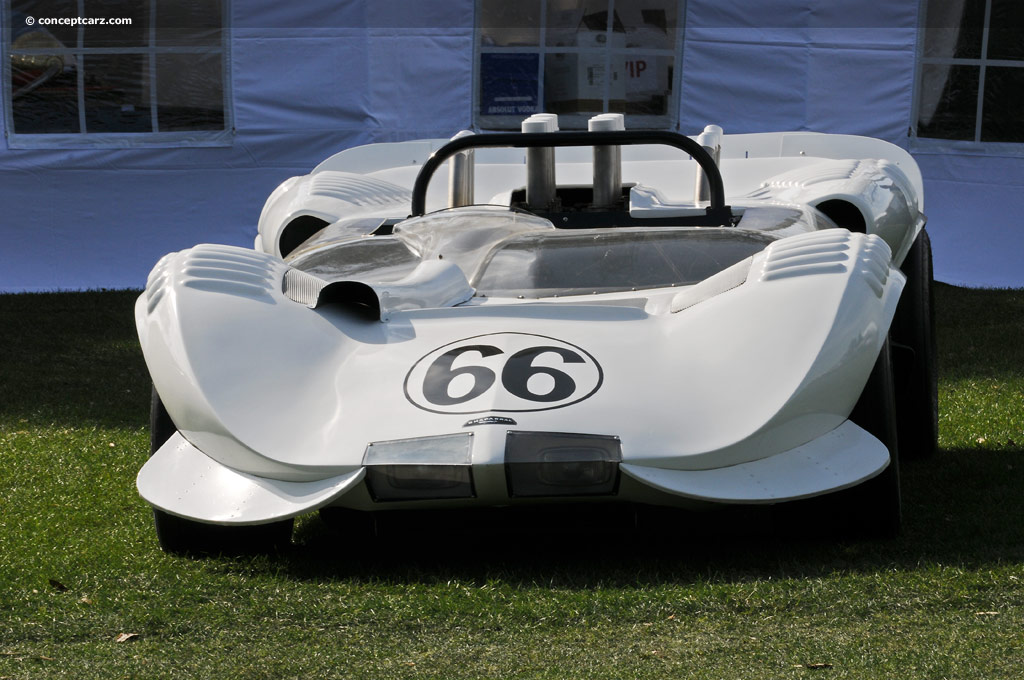
Sports Racer
Chassis #: 2002
View info and history
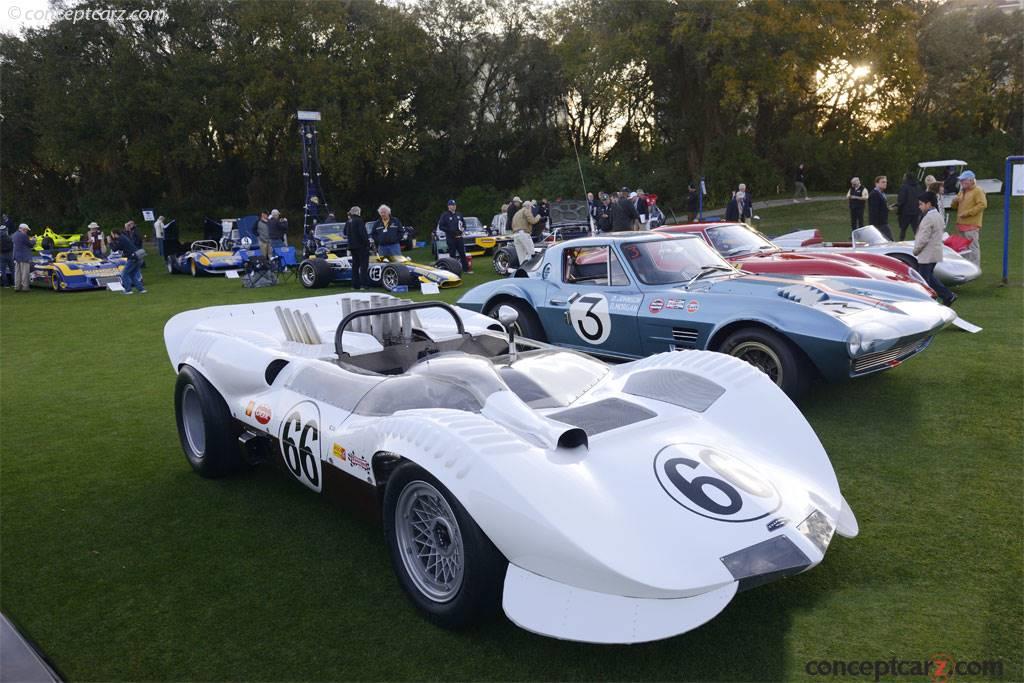
Sports Racer
Chassis #: 2002
View info and history
by Daniel Vaughan | Mar 2012
1963 Chaparral 2 Vehicle Profiles
Recent Vehicle Additions
Related Automotive News

From Lucybelle to DHL: Historic Porsche Competition Cars Race to Gooding & Company's Pebble Beach Auctions
The very best of Porsche excellence will come to Pebble Beach with a 1959 Porsche 718 RSK, a 1969 Porsche 90802, a 2007 Porsche RS Spyder Evo, and more.
Gooding %26 Company, the official auction house of the Pebble Beach Concours dElegance®,...

Historic Lotus 19 Raced By Moss, Hill, Ireland And Clark Comes To The Open Market For The First Time In 57 Years
1960 Lotus 19 Monte Carlo, Chassis 953
Raced by some of the greatest British racing drivers
Jim Clark won in this car at Oulton Park in 1964
Signed by Sir Stirling Moss and the last car driven by him as a professional race driver
First raced in 1...

CHEVROLET TO SHOW CHAPARRAL VISION GRAN TURISMO CONCEPT
Boundary-pushing, Chevy-powered race cars changed motorsports design
DETROIT – When racers Jim Hall and Hap Sharp founded Chaparral Cars in 1962, few could have guessed how they would shake up the conformities of the racing world – and...
RRDC VOTES IN 37 NEW MEMBERS FOR 2013
HILLIARD, Ohio (Nov. 7, 2013) - Thirty-seven race-car drivers and motorsports professionals have been voted into the Road Racing Drivers Club in 2013. The group includes 13 Regular Members from the open-wheel and sports-car racing ranks, 20 Associate...

1967 Can-Am Road America: The Beginning of the 'Bruce and Denny Show'
While Formula One will be forever considered the pinnacle of motorsport, from a period between 1966 and 1986 there existed a series that would likely be the closest to anything goes as any motor racing series could truly get. Based upon the FIA Group...










